These two Prakticas were made by VEB Pentacon as part of the 4th generation of the Praktica 35mm single lens reflex series between the years of 1963 and 1966. The model on the left is a model IV F, and the one on the right is a model V F. Although sporting different model names, the cameras are nearly identical with the only differences between the two is that the V F has a rapid return mirror and uses the modern spacing of shutter speeds, whereas the IV F stays in the up position after firing the shutter and has a different range of shutter speeds. These cameras were both well built and sturdy, fully mechanical cameras using the popular M42 “Praktica” lens mount. Pentacon would continue to produce cameras using the Praktica name until as recently as 2001, but these two models represented the last of the original series of cameras originally designed by Kino-Werke Dresden (KW).
Film Type: 135 (35mm)
Lens: 50mm f/2.8 Carl Zeiss Jena Tessa coated 4-elements (two different variants)
Lens Mount: M42 Screw Mount
Focus: 1.65 feet to Infinity
Viewfinder: Fixed SLR Prism with Fresnel screen and split image focus aide (instant return mirror on V F)
Shutter: Cloth Focal Plane
Speeds: B, 1/2 – 1/500 seconds
Exposure Meter: None
Battery: None
Flash Mount: F and X Flash Sync
Weight (body only): 702 grams (IV F), 700 grams (V F)
Weight (w/ lens): 881 grams (IV F as pictured), 853 grams (V F as pictured)
Manual: http://www.cameramanuals.org/praktica_pdf/praktica_iv-vf.pdf
Manual: http://www.cameramanuals.org/praktica_pdf/praktica_vf-vfb.pdf
How these ratings work |
Both the Praktica IV F and V F represent the last of the Praktica line with input from the original Kino-Werke Dresden (KW) designers who created the model back in the late 1940s. These were the first models with a pentaprism viewfinder, a rapid wind lever, and features like an auto returning mirror. Despite not being called a professional camera, the Prakticas have a very high build quality, excellent handling, a very bright and easy to use viewfinder, and when paired with any number of excellent M42 screw mount lenses, were capable of outstanding photographs. If you’ve never considered a Praktica before as either a user or to add to your collection, this is one you should really look at. | ||||||
| Images | Handling | Features | Viewfinder | Feel & Beauty | History | Age | |
| 2 | 2 | 1 | 2 | 2 | 1 | 20% | |
| Bonus | +1 for overall greatness, the complete package | ||||||
| Final Score | 13.0 | ||||||
History
If you were to ask someone to name the most successful camera brands from the 20th century, specifically 35mm SLR camera brands, I have to assume that names like Nikon, Canon, or perhaps even Minolta, Olympus, or Pentax would be the most common responses. Yet, according to Mike Otto’s excellent Praktica collection website, over 7.7 million Prakticas were produced, making them one of the most successful and longest lived 35mm SLR marques in the history of the industry.
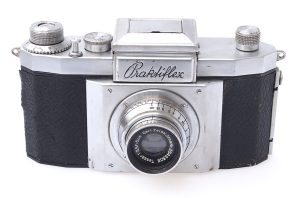
Tracing it’s roots to other eastern Germany based camera makers like Kamera-Werkstätten Guthe & Thorsch (KW) and Zeiss-Ikon Dresden, the Praktica evolved from a camera called the KW Praktiflex, released in 1939. The Praktiflex was designed by Alois Hoheisel and was the second German made 35mm SLR, second to the Ihagee Exakta. Unlike the Exakta, which was a complex and feature rich camera, the Praktiflex was very basic. Featuring a simple focal plane shutter, 40mm lens mount, and a waist level finder, the Praktiflex opened the door to what was then considered “new” 35mm film. It sold for around 120 Reichsmarks, which put it within reach of the amateur photographer.
Unlike many German optics manufacturers, KW continued production of the Praktiflex throughout the course of World War II, offering it in variety of military and civilian versions. Despite being generally regarded as a “Dresden area” maker, KW’s primary factory was not actually in Dresden, but rather a nearby suburb called Niedersedlitz where it escaped damage from Allied bombing raids on Dresden in early 1945. It was this good location that allowed KW to be the only German maker of cameras still in operation immediately following the war.
Dresden is in what would become Soviet controlled East Germany, and all nearby camera companies would fall under the jurisdiction of the Soviet government. In 1948, KW would officially be reorganized VEB Kamera-Werkstaetten Niedersedlitz. The abbreviation VEB stands for Volkseigener Betrieb which translates to ‘Publicly Owned Operation’ in English and was the main legal form of industrial enterprise in East Germany from the late 1940s until the early 1960s. In late 1945, the government controlled Soviet Military Administration in Germany (SMAD) would set an annual production goal of 50,000 cameras by the KW factory, a number that was unattainable, largely due to the hand crafted precision parts required for their cameras.
In January 1946, SMAD would transfer a prominent engineer from the nearby Zeiss-Ikon factory named Siegfried Böhm to KW in an effort to help improve the speed and efficiency of it’s output so they could meet their lofty goals. Böhm’s first changes involved a simplification of the Praktiflex’s design and a switch of the lens mount from a proprietary M40 to an all new M42 design. The revised camera was called the Praktiflex II and could be made faster and cheaper than the original model.
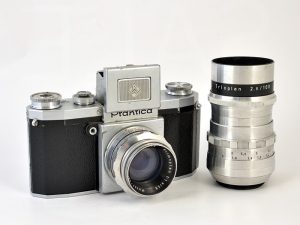
In addition to the revised Praktiflex, in 1949 Böhm introduced a completely new model called the Praktica which was similar to the Praktiflex, but had more modern controls, the larger 42mm screw mount originally designed by Zeiss for their Contax SLR, a simpler shutter, and could be sold at a price that was within the reach of most amateur photographers. The Praktica was an immediate success, helping to reestablish KW as a premiere maker of German built 35mm cameras. Although considered a modern camera at the time, early Prakticas still lacked many features we take for granted today such as a pentaprism viewfinder, auto returning mirror, or any sort of metering or electronics.
In 1952, a revised model called the Praktica FX was released which added flash synchronization and a few minor improvements. The name Praktiflex was re-used for export versions of the Praktica, but otherwise was identical, and would be the last time the name “Praktiflex” was used. There would be many subtle revisions of the FX-series throughout the 1950s, but they would all retain the same basic feature set of a cloth focal plane shutter, waist level finder, and knob wind film advance.
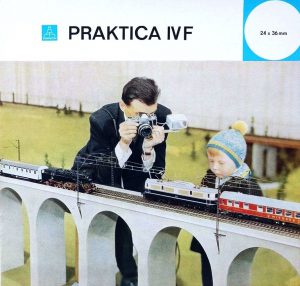
The first major revision to the Praktica came in June 1959 with the release of the Praktica IV. Featuring the lineup’s first ever pentaprism viewfinder, the Praktica IV was finally able to compete with the growing number of high quality Japanese and German SLRs being made at this time. Other advancements to the Praktica IV was an all new bottom wind film advance, a revised rewind knob, and an automatic diaphragm. Several revisions of the IV would be released adding features such as a Fresnel viewing screen, split image focus aide, and a selenium light meter.
 The Prakticas IV and V were heavily exported out of Germany and sold in many different countries including the United States. US Importers such as Pentina Camera Co. of New York City emphasized the reputation of Carl Zeiss lenses and German build quality to help sell their cameras. In the June 1965 ad to the left, the Praktica IV F and V F each sold for “under” $150 and $160 respectively. When adjusted for inflation, that is comparable to $1200 and $1275 today.
The Prakticas IV and V were heavily exported out of Germany and sold in many different countries including the United States. US Importers such as Pentina Camera Co. of New York City emphasized the reputation of Carl Zeiss lenses and German build quality to help sell their cameras. In the June 1965 ad to the left, the Praktica IV F and V F each sold for “under” $150 and $160 respectively. When adjusted for inflation, that is comparable to $1200 and $1275 today.

In 1964, during production of the Praktica IV, the East German government, in an effort to consolidate resources and workforce would combine nearly every Dresden area optics company into a single entity, known then as VEB Pentacon Dresden which would continue until the fall of the Berlin Wall in 1989.
In December 1964, a revised model called the Praktica V F would be released that would be identical to the models before it, only adding an instant return mirror and adopting the modern system of numbering shutter speeds (i.e. 30, 60, 125, 250, etc). Models with and without a meter were available as well. Both the Praktica IV and V models were produced concurrently until January 1966 at which time the Praktica Nova series would take their place.
Pentacon would continue with the Praktica lineup for the next several decades, continuing to refine, but never radically change the successful formula of a solid and heavy mechanical camera. Perhaps mimicking the socialist philosophy of building products for the greater good, the Praktica rarely innovated new features. Things like electronic shutters, automatic exposure, motor drive, and full information viewfinders would eventually make their way into later models, but would always be far behind the release of those same features by other companies.
Despite their socialist origins, the Praktica lineup was popular all over the world, and exported to nearly every country, including the United States. The Praktica L series saw the greatest success with at least 4.8 million cameras produced between 1969 – 1989.
Today, Prakticas aren’t very collectible, simply due to how common they are. So many were made over the course of nearly half a century that if you are a fan of old cameras, you tend to just stumble upon them. Like with any popular series, there are models that are rarer than others, and I suppose the Prakticas IV and V meet that requirement as they’re not ones you see very often, especially not in the United States. Being the last models to have been produced under the original KW name, the Prakticas IV and V for me are the best combination of modern features, but still in the spirit of the original camera. They’re generally well built, and due to their simplicity, can often still be found in good working condition, assuming they haven’t been abused.
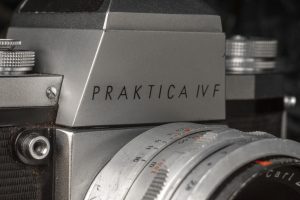
My Thoughts
I just finished the History section above saying how common Prakticas are and that collectors tend to stumble upon them, but I’ll contradict myself and say that as of earlier this year, I had yet to have one in my collection.
This omission was noticed by a reader of my site named Paul Snaith from the UK who in January, contacted me saying that he would be willing to send me a Praktica if I would agree to review it. I was grateful for his generous offer and gladly took him up on it. After a few email exchanges with Paul, we settled on a nice Praktica IV F which he would send to me. Being in the UK, it took a little bit of time for the package to arrive, but as the saying goes, “when it rains it pours”, before the IV F could arrive, I managed to stumble upon a Praktica V F at a local garage sale! So within a matter of a couple of weeks, I had not one, but two Prakticas ready for a future review on the site.
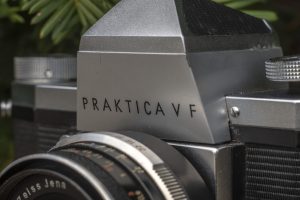
Despite the suggestion that the V F is some type of 5th generation Praktica, the camera is nearly identical to the IV F with the biggest difference being that it has an instant return mirror and an updated range of shutter speeds. For anyone who has never shot an old SLR, instant return mirrors are one of those features that you take for granted and never even consider that there might have been a time where cameras didn’t have them. It’s kind of like buying a car before turn signals, rear view mirrors, or even (gasp) air conditioning were commonly found!
Without an instant return mirror, the mirror remains in the upright position, blocking light from entering the viewfinder when the shutter is not cocked. Upon advancing the film and cocking the shutter, the mirror lowers into the down position allowing light from the lens to reflect into the viewfinder. Unlike later SLRs where the viewfinder goes dark only for a moment while the shutter is open, with these cameras, it stays dark until you cock the shutter again.
This doesn’t make a big difference when composing your image as it will work like pretty much any other SLR, but it can become jarring to lose sight of your composition upon firing the shutter. The inability to see your composition at the moment of exposure and immediately after was one of the reasons that professional photographers preferred rangefinders over early SLRs in these days. While other features helped to popularize SLRs for pros, the instant return mirror was definitely a big one.
Beyond the instant return mirror and changed shutter speeds, the two cameras are the same, from the cosmetics, viewfinder, ergonomics, and even the lens availability, so for the purposes of this review, everything I say would apply to both cameras. In both cameras, the slow speeds didn’t work, but all of the fast ones seemed fine, so I just never selected a shutter speed lower than 1/25 (1/30 in the V F). Paul’s Praktica came to me body only, so I was able to pair it with an earlier all metal Zeiss Tessar that I purchased from Central Camera in Chicago in June 2017 for my Zeiss-Ikon Pentacon FM review. The Praktica V F came with a later Zeiss Tessar with a redesigned body and leather focusing ring. Looking up the serial numbers of the two lenses, the earlier one likely was made in 1960 and the later one in 1963. Regardless of the cosmetics, the two lenses should be optically identical.

Looking down upon the top of the camera shows quite a bit of detail which if your only experience with a Praktica was from a later generation, you wouldn’t expect to see. The top of the prism sports a nice textured covering matching the textured body covering elsewhere on the camera. This styling cue likely was inspired by both the KW Praktina and Zeiss Contax that came before it.
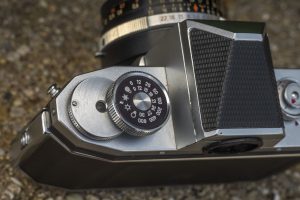
The rewind knob has a nice chromed texture around the edge and a black film speed reminder dial, but it hides a neat feature that I’ve never seen on another camera. Instead of a flip-up lever like pretty much every Japanese SLR ever made, the rewind knob has an upper and lower half that is hinged in one side which allows you to swivel the top half 180 degrees away from the bottom half, allowing for a bit of a “rapid wind” feature. Functionally, its not as nice as a standard lever like everyone else used, but it certainly looks cool.
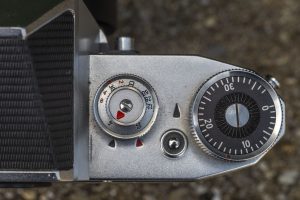
On the right side of the camera is the two piece shutter speed dial. In the center of the shutter speed dial is a separate dial with a red arrow that is used to switch between slow and fast shutter speeds. This red arrow must be lined up with either a second red or black arrow painted on the top plate. With the red arrow pointing to the black arrow, fast speeds from 1/25 – 1/500 are selected (1/30 – 1/500 on the V F). There is also a black lighting bolt symbol that is for electronic flash sync and uses a shutter speed of 1/40. With the red arrow pointing to the other red arrow, slow speeds from 1/2 – 1/10 are selected (1/2 – 1/8 on the V F). Finally, there is a “B” for Bulb mode which can be chosen regardless if the slow or fast speeds are selected.
To the right of the shutter speed dial is the rewind release knob which must be pressed to rewind film at the end of the roll, and the film advance knob with exposure counter on top. Like the rewind knob, the advance knob is also nicely chrome plated with a deep knurl to the edges allowing for a secure grip.
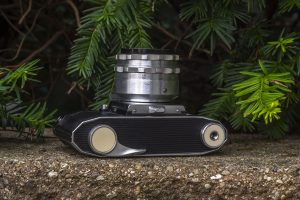
On the bottom of the camera is both the standard 1/4″ tripod socket set in an offset ring, and on the other side an elegantly contoured film advance lever. Wait a minute, didn’t you already say there was a film advance knob on top of the camera? Yep! Both the Prakticas IV and V have both a knob and a lever, and both can be used to advance the film and cock the shutter! I honestly have no idea why KW went this route with the Praktica as by the time of it’s release, top wind levers were already quite common, and it wouldn’t have taken much to replace the top knob with a lever, but regardless of the reason, its a unique implementation that I haven’t seen in anything else.
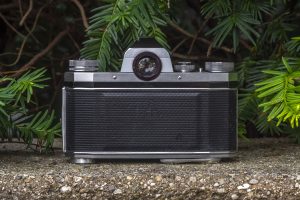
The back of both cameras show the large circular eyepiece for the viewfinder, which has some type of bayonet style ring for installation of eyepiece accessories such as diopters or critical focus eye pieces. On the door itself is a large swath of body covering with an embossed logo of the Ernemann tower in the center. The Ernemann tower was originally finished in 1923 and was the central headquarters of what was then Ernemann Kamera-Werke. Upon it’s completion, it was the largest building in all of Germany, and a source of pride for the Dresden area camera industry. The tower was featured in the logo for all Pentacon products which suggest that both the IV F and V F being reviewed here were built after the change from KW to Pentacon.
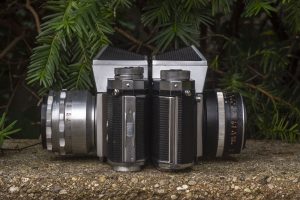
To load film into the camera, you must press a door release latch on the camera’s left side which will allow you to swing open and remove the entire door. Unlike other cameras with removable backs where the bottom comes with the door, the Prakticas IV and V have just a removable back. This is consistent with the KW Praktina from a few years earlier, although the backs of the Praktina and Praktica are not interchangeable.
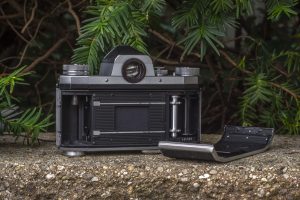
With the back removed from the camera, film loading is a snap. A new cassette loads on the left, with the film leader connecting to a fixed metal take up spool on the right. The spool rotates clockwise meaning the film is wound in the opposite direction of how it is in the film cassette, which is said to help improve film flatness.
The entire film compartment is very elegantly designed and shares more in common with the professional Praktina, suggesting that KW still inserted German design into their cameras prior to the Soviet “function over form” mentality that would be prevalent in later models. The back of the mirror box has a nice horizontal pattern on it breaking up the usual sea of black that adorns most film compartments, the dual sprocket shaft is a solid piece of brushed stainless steel, and the film pressure plate is a solid piece of smoothly polished metal to ensure effortless film transport across the film plane. These Prakticas pre-date the use of foam light seals, so the fabric based seals on both of my examples were in good shape and did not need to be replaced.
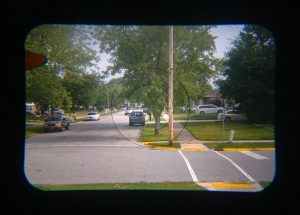
The viewfinders in the various Praktica IV and V models change depending on which variant you have. Both of these have the letter “F” in the model name, which mean that it has a Fresnel screen and split image focus aide. There existed other variants of these cameras with a ground glass screen and without the split image aide. I found the presence of this upgraded screen to be a huge benefit to both cameras as the viewfinder was very bright and easy to compose your image with. The very large split image aide makes achieving focus very easy. I’ve used SLRs with ground glass only viewfinder screens and they aren’t nearly as pleasant to work with. It is this one single feature that in my opinion really elevates both Prakticas as an excellent user camera.
In the previous image to the left, you’ll notice an orange triangle “flag” in the upper left corner which is only present on the Praktica V F. This flag is there to let you know that the shutter has not been set and that you should advance the camera before taking your image. Since the IV F does not have an instant return mirror, the viewfinder is completely dark when the shutter is not set, but in the V F, you can see through the viewfinder as normal, so the designers must have thought this would be a useful reminder.
In the short time I handled both Prakticas after receiving them, I already had a real good idea that these were special cameras. My earlier thought that Prakticas were rudimentary instruments of Cold War era East Germany, and had little to offer a serious photographer or collector, were starting to fade. Other than the lack of a top 1/1000 shutter speed (which usually isn’t accurate in vintage cameras anyway), there’s really nothing missing from this camera that would prevent it from being an ideal shooter. My fondness for these cameras continued to grow each time I looked at them, and I knew I wouldn’t be able to go too much longer without loading one with film and taking it out, so that’s what I did!
My Results
In keeping with a theme of trying out something donated to me by a European reader of my site, around the same time I received the Praktica, I was discussing ORWO films with professional photographer Eric Kass Sluis of Belgium. Eric had offered to send me a selection of some expired ORWO film that he had a large supply of, and since I am never one to turn down free stuff, I said sure!
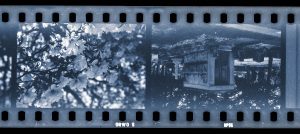
Eric would send me a variety of film, but the one that I was most interested in was a cinema film called NP55, which was a slow speed cinema film that he said was from the late 1970s. If you’re interested to learn more about this film, Hamish Gil did an excellent interview with Eric regarding his use of expired film, including NP55 on his site, which I strongly recommend reading.
In any case, Eric suggested I shoot this film as if it were an ASA 40 speed film, but the big question was, what camera should I shoot it in. The answer became very obvious once I had the Prakticas in my hand. What better way to shoot old East German film donated to me by a European photographer, than a camera made in East Germany, and donated to me by another European photographer. I would end up choosing the Praktica V F for this roll as I appreciated the instant return mirror. I felt as though the cameras were so similar, and could have easily swapped lenses, so any observations I might have while shooting would apply to both cameras so what follows are results from only one of the two cameras in this review.
There are many excellent blogs out there devoted to specific film stocks, and shooting a rare film stock such as ORWO NP55 is probably deserving of it’s own post, but I lack the eye for what makes one film stock better or worse than another, not to mention the time to write a separate article for just the film, so what follows is a combination of both a film stock and camera review.
I will say that I absolutely understand Eric’s infatuation with ORWO NP55. The film grain is very minimal, and contrast levels are exactly what I like to see in black and white film. I am not a huge fan of strong grain or high contrast photography as I don’t like the harshness of it. I’ve gotten excellent results from other expired film stocks such as Kodak Panatomic-X, Verichrome Pan, AGFA APX 25, and Fuji Neopan 400, but I must say that the ORWO is perhaps my favorite. It was a bit of a risk shooting such an obscure film in an old camera that I had never used before, but it turned out that any worry I might have had was unfounded, as the Praktica V F performed flawlessly.

I shot everything using Sunny 16, and utilized good lighting outdoors. Eric had told me he develops his films in something called Calbe A-49 which is not commonly found in the US, so he recommended D-76 as a suitable replacement. Being the fan of Kodak’s HC-110 that I am, I wanted to see if there was any information out there for this type of film using HC-110.
Thankfully, the Masive Dev Chart over at digitaltruth.com has an entry for ORWO NP-55 using Dilution B for 6 minutes. Dilution B from syrup is mixed in a 1 to 31 ratio and since I use 500ml Paterson tanks, I find that a 500ml to 15ml ratio works fine for me. I followed my normal instructions for developing HC-110 and crossed my fingers during the final stages, and to my excitement, when I pulled the film from the tank, I had a whole strip of what looked to be nicely developed images!
My experience shooting the Praktica V F was outstanding. Considering I had previously thought that all Prakticas were nothing to get excited about, I was now a believer. The large and bright viewfinder made the experience a great one. With the inclusion of an instant return mirror on the V F, front shutter release, and rapid wind lever, I felt very comfortable throughout my first roll. Although the ORWO film gets a lot of credit for the excellent black and white images above, the camera performed admirably as well, with no hiccups, no light leaks, and no issues with the shutter.
I don’t know that I’ll necessarily start collecting a huge number of Praktica cameras, but this experience has opened to my eyes to the lineup and it’s one that I am extremely thankful to Paul Snaith for extending the offer to send me his camera! If you have an opportunity to try either the IV F or V F, let me be your Paul, and prompt you to go for it!
Additional Resources
http://www.praktica-collector.de/145_Praktica_IVF.htm
http://www.praktica-collector.de/147_Praktica_VF.htm
http://camera-wiki.org/wiki/Praktica_IV
https://johns-old-cameras.blogspot.com/2015/12/praktica-iv.html

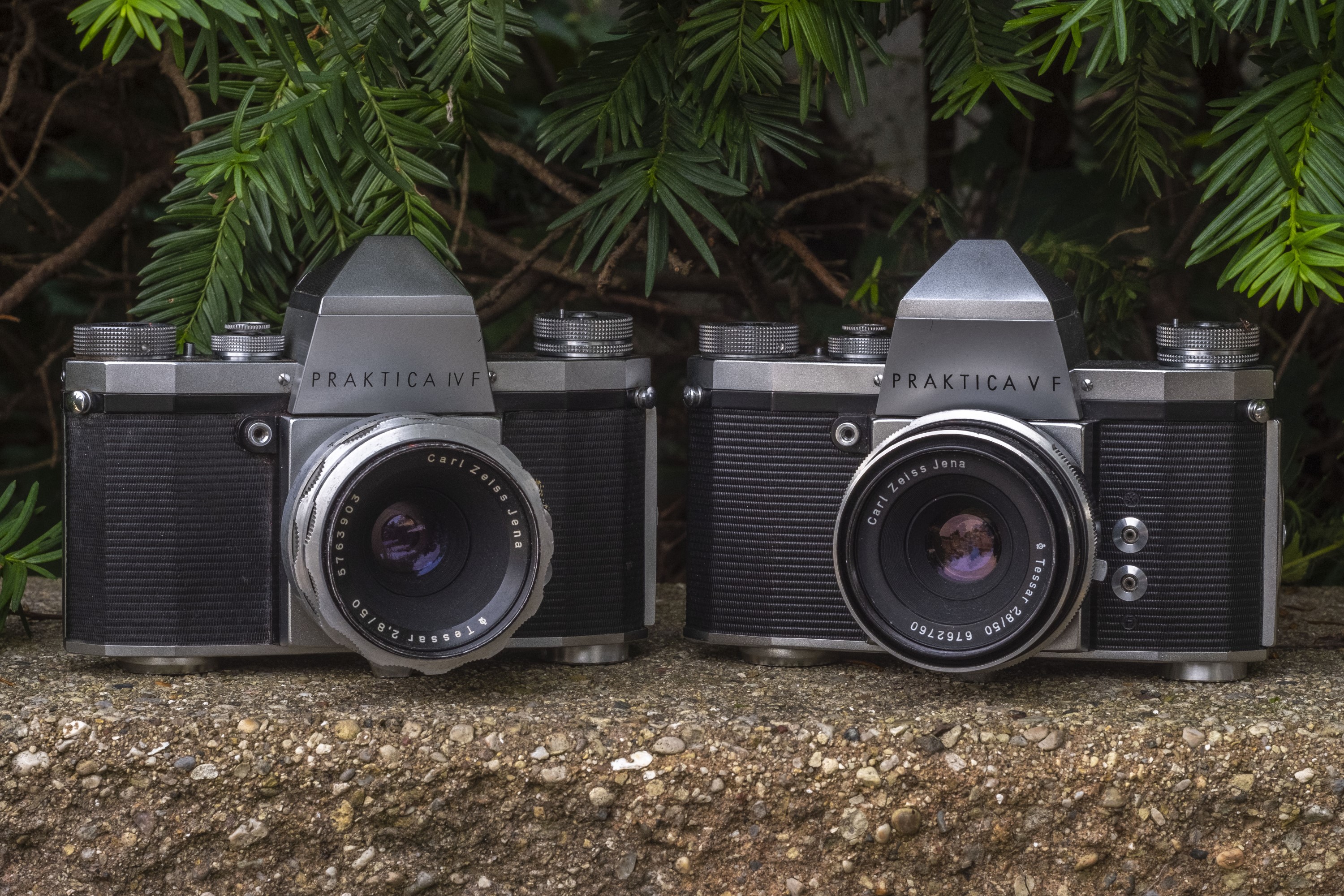
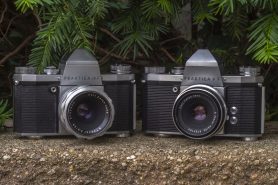
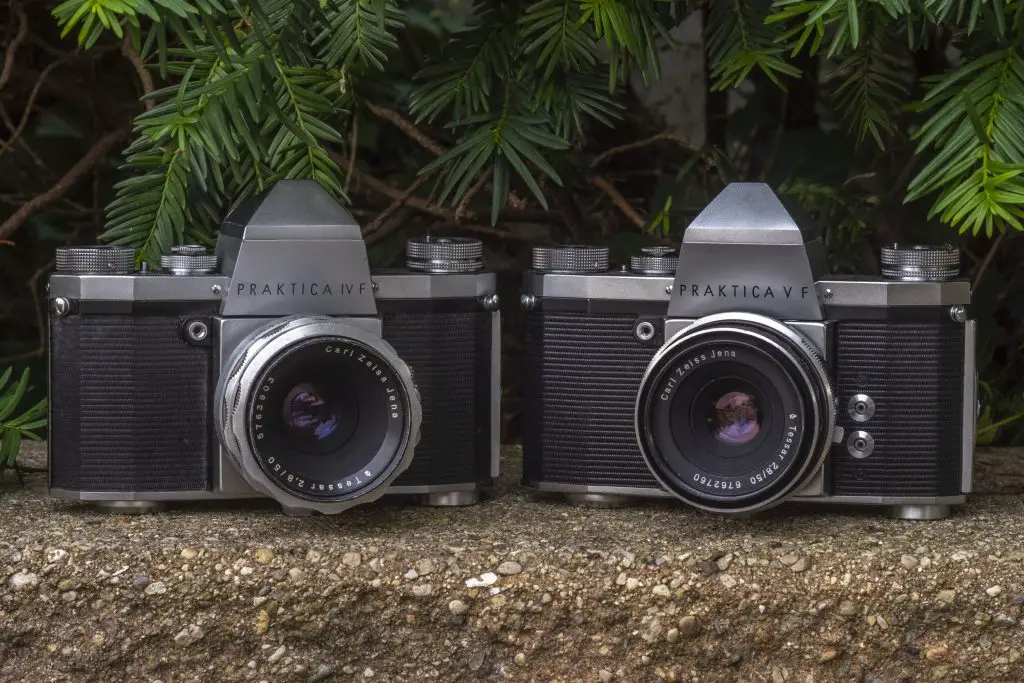












I enjoyed your assessment of these cameras, a Practica IV was my first camera back in 1965 and it’s still going alongside FX2s, FX3s, IVFB and a V. I use them occasionally and their shutters still function, with the range of Carl Zeiss, Meyer, Schneider and Asahi lenses you can get top class results.
A very good assessment of these cameras. My first camera in 1965 was a Praktica IV and I still have it alongside FX2s and FX3s, a IVFB and a V. I have a considerable collection of cameras and use CSCs and Leica rangefinders but I still have a soft spot for these cameras. You can mount Carl Zeiss, Meyer, Schneider, Schact, Asahi and hosts of other M42 lenses on them and get fine results.
The design reminds me a bit of the Kodak Retina reflexes (non-returning mirrors, film advance on the bottom, overall shape). Unlike teh Retina Reflexes, it has a focal plane shutter and M42 threads.
I have a soft spot in my camera heart, for Dresden made cameras, and typewriters. These Prakticas, are arguably some of the best, and most useable, next to the Exaktas.
Glad you now approve of them, and very nice review! Thanks
Thanks for the feedback Don, but am I understanding you correctly, that you wish I start reviewing vintage typewriters too?! 🙂
What a comprehensive review, as always. I just picked up a IV F, and what a magnificent camera it is. This is one of the nicest cameras I have used, and I have used a lot.
What an excellent review. I have a VF sat on my desk at work looking a me ! It is missing the little stand so as three holes in the bottom ! I’m being made redundant this month so the camera is coming home with me, your review inspiring me to get it fixed and now I’ll have loads of spare time, get some films through it.
Definitely get that camera out shooting! Although I wrote this review a couple of years ago, I still have a fondness for both these Prakticas. They’re a joy to use and I am certain you’ll be happy with yours!